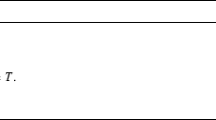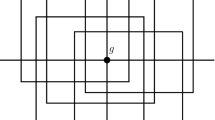Abstract
In the Minimum Weight Partial Connected Set Cover problem, we are given a finite ground set \(U\), an integer \(q\le |U|\), a collection \(\mathcal {E}\) of subsets of \(U\), and a connected graph \(G_{\mathcal {E}}\) on vertex set \(\mathcal {E}\), the goal is to find a minimum weight subcollection of \(\mathcal {E}\) which covers at least \(q\) elements of \(U\) and induces a connected subgraph in \(G_{\mathcal {E}}\). In this paper, we derive a “partial cover property” for the greedy solution of the Minimum Weight Set Cover problem, based on which we present (a) for the weighted version under the assumption that any pair of sets in \(\mathcal {E}\) with nonempty intersection are adjacent in \(G_{\mathcal {E}}\) (the Minimum Weight Partial Connected Vertex Cover problem falls into this range), an approximation algorithm with performance ratio \(\rho (1+H(\gamma ))+o(1)\), and (b) for the cardinality version under the assumption that any pair of sets in \(\mathcal {E}\) with nonempty intersection are at most \(d\)-hops away from each other (the Minimum Partial Connected \(k\)-Hop Dominating Set problem falls into this range), an approximation algorithm with performance ratio \(2(1+dH(\gamma ))+o(1)\), where \(\gamma =\max \{|X|:X\in \mathcal {E}\}\), \(H(\cdot )\) is the Harmonic number, and \(\rho \) is the performance ratio for the Minimum Quota Node-Weighted Steiner Tree problem.
Similar content being viewed by others
References
Bar-Yehuda R (1999) Using homogeneous weights for approximating the partial cover problem. In: Proceeding of tenth annual ACM-SIAM symposium on discrete algorithms, pp 71–75
Bshouty N, Burroughs L (1998) Massaging a linear programming solution to give a 2-approximation for a generalization of the vertex cover problem. In: Proceedings of annual symposium on the theoretical aspects of computer science, pp 298–308
Chvatal V (1979) A greedy heuristic for the set covering problem. Math Oper Res 4:233–235
Elbassioni K, Jelic S, Matijevic D (2012) The relation of connected set cover and group Steiner tree. Theor Comput Sci 438:96–101
Feige U (1998) A threshold of \(\ln n\) for approximating set cover. J ACM 45(4):634–652
Gandhi R, Khuller S, Srinivasan A (2001) Approximation algorithms for partial covering problems. In: Proceedings of the 28th international colloquium on automata. Languages and Programming, Crete, Greece, pp 225–236
Garg N (2005) Saving an epsilon: a 2-approximation for the \(k\)-MST problem in graphs. In: STOC, pp 396–402
Halperin E, Srinivasan A (2002) Improved approximation algorithms for the partial vertex cover problem. In: Approximation algorithms for combinatorial optimization, pp 161–174
Hochbaum DS (1998) The \(t\)-vertex cover problem: extending the half integrality framework with budget constraints. In: Proceedings of first international workshop on approximation algorithms for combinatorial optimization problems, pp 11–122
Johnson DS (1974) Approximation algorithms for combinatorial problems. J Comput System Sci 9:256–278
Johnson DS, Minkoff M, Phillips S (2000) The prize collecting Steiner tree problem: theorem and practice. In: SODA, pp 70–769
Kearns MJ (1990) The computational complexity of machine learning. MIT Press, Cambridge, MA
Khandekar R, Kortsarz G, Nutov Z (2009) Approximating fault-tolerant group steiner problem. In IARCS annual conference on FSTTCS, pp 263–274
Khuller S, Purohit M, Sarpatwar KK (2014) Analyzing the optimasl neighborhood: algorithms for budgeted and partial connected dominating set problems. In: SODA, pp 1702–1713
Lovasz L (1975) On the ratio of optimal integral and fractional covers. Discrete Math 13:383–390
Moss A, Rabani Y (2001) Approximation algorithms for constrained node weighted Steiner tree problems. In: STOC, pp 373–382
Shuai T, Hu X (2006) Connected set cover problem and its applications. Algorithm Aspects Inform Manag 4104:243–254
Slavik P (1997) Improved performance on the greedy algorithm for partial cover. Inform Process Lett 64(5):251–254
Srinivasan A (2001) Distributions on level-sets with applications to approximation algorithms. In: Proceedings of the 42nd annual IEEE symposium on foundations of computer science. Las Vegas, pp 588–597
Wolsey LA (1982) An analysis of the greedy algorithm for the submodular set covering problem. Combinatorica 2(4):385–393
Zhang Z, Gao X, Wu W (2009) Algorithms for connected set cover problem and fault-tolerant connected set cover problem. Theor Comput Sci 410:812–817
Acknowledgments
This work is supported by the NSFC (Nos. 11071191, 61222201 and 11371287), SRFDP (20126501110001) and Xingjiang Talent Youth Project (2013711011)
Author information
Authors and Affiliations
Corresponding author
Rights and permissions
About this article
Cite this article
Liang, D., Zhang, Z., Liu, X. et al. Approximation algorithms for minimum weight partial connected set cover problem. J Comb Optim 31, 696–712 (2016). https://doi.org/10.1007/s10878-014-9782-5
Published:
Issue Date:
DOI: https://doi.org/10.1007/s10878-014-9782-5




